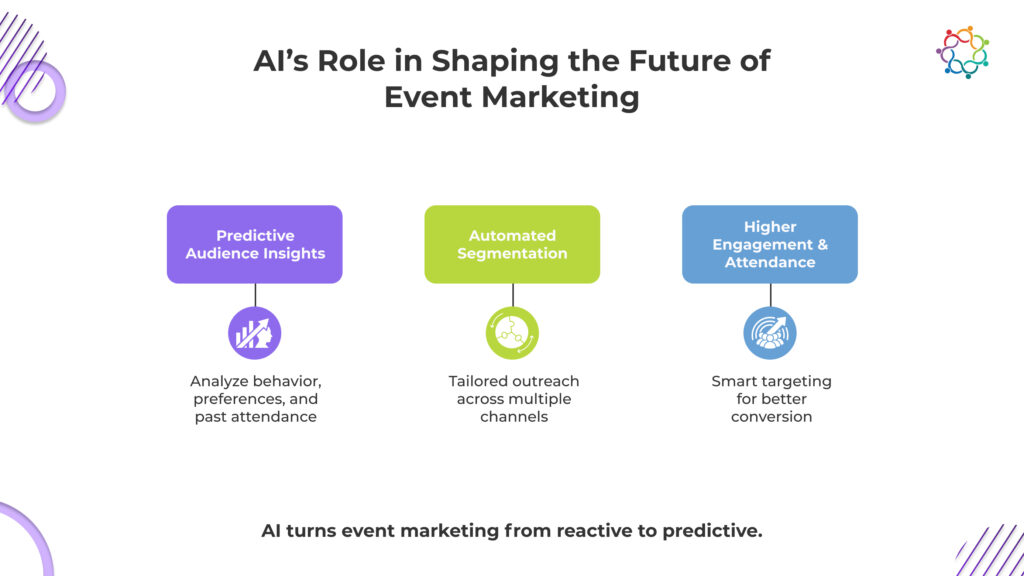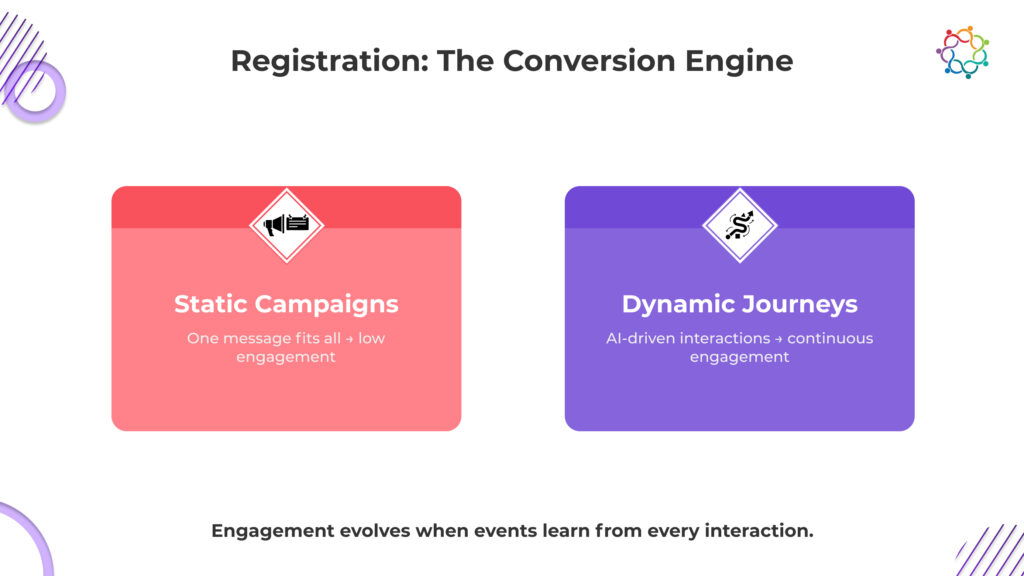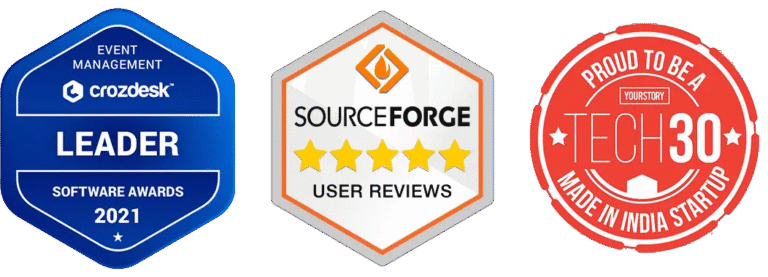Samaaro + Your CRM: Zero Integration Fee for Annual Sign-Ups Until 30 June, 2025
- 00Days
- 00Hrs
- 00Min

The future of event marketing is prediction, not reaction. By 2026, campaigns will begin long before the registration opens. Using AI models to analyse audience data, prior attendees, and engagement metrics, we will have the ability to predict how the campaign is likely to perform. This predictive intelligence can help marketers decide which channels deserve more spend, the content that drives conversion, and how to balance awareness and retention.
No longer are static campaigns effective. Brands are using adaptive strategies to personalise their outreach in real-time as the behaviour of attendees unfolds. A financial services firm can now predict which attendees are most likely to convert into investors, even before the event begins. Benefits include better engagement and content returns, as well as less wasted impressions.
To truly understand this transformation, it helps to think of events as living, learning systems powered by data. Instead of one-off campaigns, brands now run continuous engagement loops where every click, RSVP, and interaction feeds insights back into the system, creating smarter future events. For a deeper dive into the evolving strategies shaping this shift, explore Samaaro’s comprehensive guide on event marketing trends: Event Marketing 2025: Strategies That Deliver Real Results.

AI has become the intelligence behind every successful campaign. Predictive analytics allows organisers to see who will likely attend or how they will still engage with content and confidently move the audience from interest to action. Automated segmentation refines how you can appropriately target your audiences, ensuring that meeting each communication touchpoint from invitations through to post-event reminders will resonate.
AI chatbots engage attendees at the early stages of the event process by not just qualifying leads but also answering questions in real-time. AI chatbots can also detect sentiment from responses, enabling marketers to see if there is excitement or hesitation so that follow-up can be appropriately tailored. Some organisers have indicated an increase of over 40% registration engagement when adding an AI-driven marketing workflow to their pre-event campaigns.

Audiences do not exist anymore exclusively on a single channel. They may have received the initial invite via email, followed the updates on LinkedIn, RSVP’d on WhatsApp, and participated in the event via a mobile application, all the while playing out an attendee journey. This is the direction for the future of event marketing; an omnichannel personalisation of the attendee journey that feels seamless, relevant and consistent at every touchpoint.
AI enables brands to link all these touchpoints and allow for one continuous attendee journey. A BFSI firm, for instance, can track how an attendee is engaging with its email, ads, and mobile app, and build a picture of its preferences, thereby delivering a fully personalised experience. Rather than fussing with outreach across silos, brands are delivering one experience with consistency across platforms, creating comfort and trust.

As of 2026, the concept of audience engagement is focused on real-time engagement, not just giveaways or gimmicks. The use of AI to monitor engagement signals delivered during the session and then help modify the event experience is what’s possible. When attention metrics drop, the virtual technology could activate polls, suggest activating a Q&A, or suggest networking ways to boost energy levels.
Also, session attendees could receive intelligent alerts / reminders throughout the event, alerts to sessions that align with their profile and previous interests, alerts when the topic was trending, and alerts to meet the featured speaker. At the event’s close, AI-generated scores would identify which attendees were engaged, allowing teams to easily prioritise follow up and sales conversations that would emerge after the event.
The event technology environment in 2026 is increasingly intelligent, predictive and ROI-focused. Organisers are no longer reliant on only a CRM or analytics dashboard; they are leveraging a new generation of AI-empowered event applications and marketing systems optimized for forecasting, automation and decision support. Some of the catalysts of change in this regard include:
Samaaro is redefining how brands plan, market, and measure events in the age of intelligence.
The platform brings together AI-driven prediction, omnichannel personalization, and revenue-focused analytics, giving event marketers the power to anticipate, engage, and optimize every attendee interaction in real time.
Samaaro’s AI engine analyses past event data, attendee demographics, and engagement behaviour to forecast campaign performance before launch.
Marketers can predict likely attendance, engagement hotspots, and sponsor ROI, transforming planning from guesswork into data-backed certainty.
Promote your event across email, SMS, WhatsApp, and push notifications, all from one platform.
Samaaro’s automation engine ensures every message adapts to audience behaviour: reminding inactive users, rewarding loyal attendees, and re-engaging high-value prospects at the right moment, on the right channel.
During the event, Samaaro tracks live attendee interactions, session participation, app engagement, and booth visits, assigning each attendee an Engagement Score.
This allows event teams and sales reps to prioritize high-intent leads instantly and trigger personalized follow-ups while interest is at its peak.
Each attendee’s journey is dynamically tailored. If someone misses a keynote, Samaaro recommends similar sessions; if they show interest in a specific sponsor, it nudges them toward related offers.
This continuous optimization ensures relevance, reduces drop-offs, and maximizes attendee satisfaction.
Samaaro connects every touchpoint, marketing, registration, attendance, engagement, and sales, into one unified, visual dashboard.
Marketers can see exactly which campaign drove which registrants, which sessions converted them, and how event spend translated into measurable pipeline value.
With native integrations into Salesforce, HubSpot, and other marketing tools, Samaaro ensures every event-generated lead flows directly into your revenue pipeline.
This means events stop being a marketing black box and become a verifiable revenue channel.
By 2026, event marketing will be dominated by marketers most successful at marrying creativity with intelligence: on the one hand, Artificial Intelligence (AI) delivers a degree of foresight; on the other hand, omnichannel personalisation accommodates interacting with consumers at every touch point. When applied together, they create for the marketer an opportunity to get rid of vanity metrics, and begin dealing with the things that really mattered, so marketers can create engagement that is meaningful, and not only measurable engagement, but ideally measurable engagement that affects growth.
If you’re interested in futureproofing your event marketing approach to develop smarter, data-driven experiences, check out Samaaro’s AI-ready event platform today- https://samaaro.com/

Built for modern marketing teams, Samaaro’s AI-powered event-tech platform helps you run events more efficiently, reduce manual work, engage attendees, capture qualified leads and gain real-time visibility into your events’ performance.


© 2025 — Samaaro. All Rights Reserved.